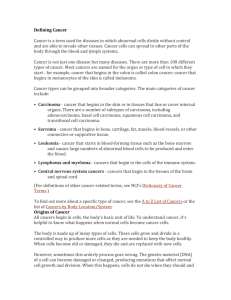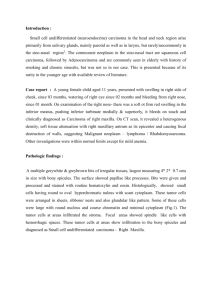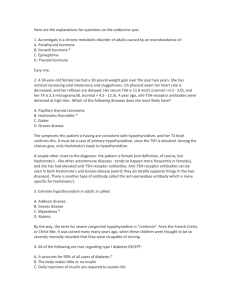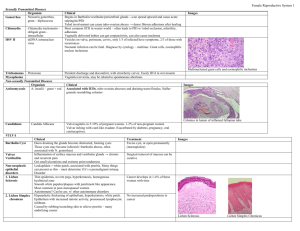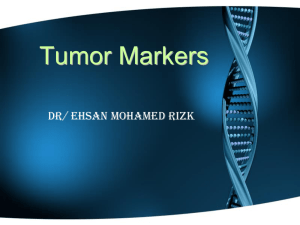pubdoc_12_30176_282
advertisement
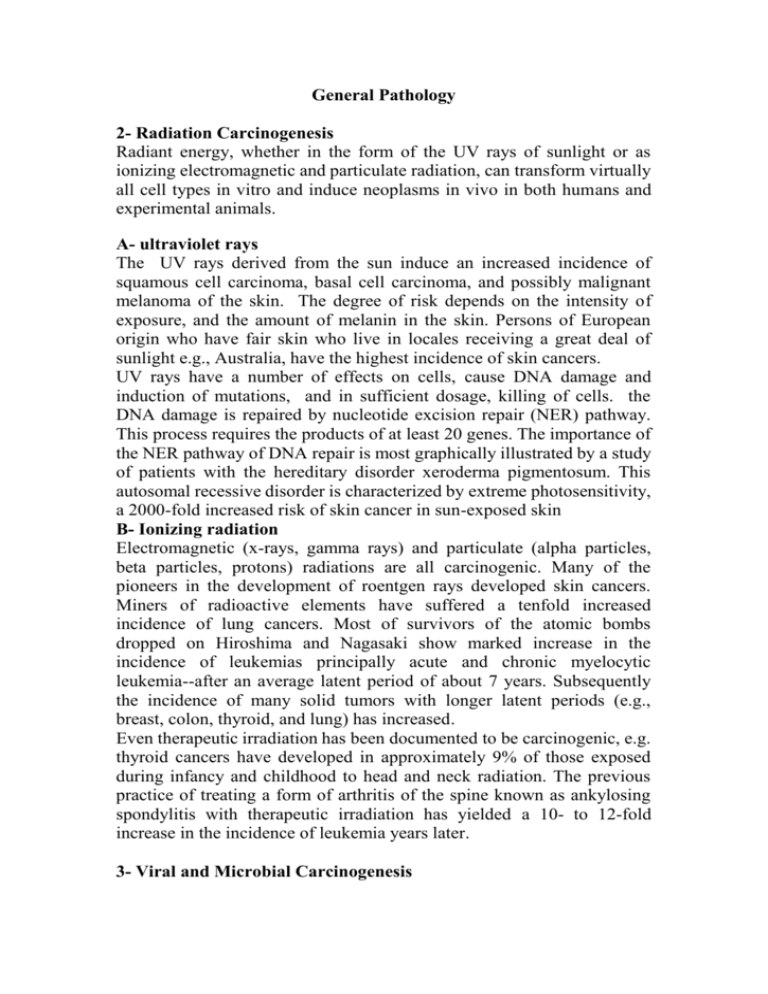
General Pathology 2- Radiation Carcinogenesis Radiant energy, whether in the form of the UV rays of sunlight or as ionizing electromagnetic and particulate radiation, can transform virtually all cell types in vitro and induce neoplasms in vivo in both humans and experimental animals. A- ultraviolet rays The UV rays derived from the sun induce an increased incidence of squamous cell carcinoma, basal cell carcinoma, and possibly malignant melanoma of the skin. The degree of risk depends on the intensity of exposure, and the amount of melanin in the skin. Persons of European origin who have fair skin who live in locales receiving a great deal of sunlight e.g., Australia, have the highest incidence of skin cancers. UV rays have a number of effects on cells, cause DNA damage and induction of mutations, and in sufficient dosage, killing of cells. the DNA damage is repaired by nucleotide excision repair (NER) pathway. This process requires the products of at least 20 genes. The importance of the NER pathway of DNA repair is most graphically illustrated by a study of patients with the hereditary disorder xeroderma pigmentosum. This autosomal recessive disorder is characterized by extreme photosensitivity, a 2000-fold increased risk of skin cancer in sun-exposed skin B- Ionizing radiation Electromagnetic (x-rays, gamma rays) and particulate (alpha particles, beta particles, protons) radiations are all carcinogenic. Many of the pioneers in the development of roentgen rays developed skin cancers. Miners of radioactive elements have suffered a tenfold increased incidence of lung cancers. Most of survivors of the atomic bombs dropped on Hiroshima and Nagasaki show marked increase in the incidence of leukemias principally acute and chronic myelocytic leukemia--after an average latent period of about 7 years. Subsequently the incidence of many solid tumors with longer latent periods (e.g., breast, colon, thyroid, and lung) has increased. Even therapeutic irradiation has been documented to be carcinogenic, e.g. thyroid cancers have developed in approximately 9% of those exposed during infancy and childhood to head and neck radiation. The previous practice of treating a form of arthritis of the spine known as ankylosing spondylitis with therapeutic irradiation has yielded a 10- to 12-fold increase in the incidence of leukemia years later. 3- Viral and Microbial Carcinogenesis A large number of DNA and RNA viruses have proved to be oncogenic in a wide variety of animals, and the evidence grows stronger that certain forms of human cancer are of viral origin. DAN Viruses: Several DNA viruses have been associated with the causation of benign as well as malignant neoplasms in their natural hosts. Of the various human DNA viruses, three (Human Papilloma Viruses[HPV], EpsteinBarr virus [EBV], hepatitis B virus[HBV], are of particular interest because they have been implicated in the causation of human cancer. 1- HPV associated with benign skin wart (papilloma), and malignant squamous cell carcinoma of cervix, and also oral and laryngeal carcinoma. 2- EBV, a member of the herpes family, has been implicated in the pathogenesis of four types of human tumors: the African form of Burkitt lymphoma; B-cell lymphomas in immunosuppressed individuals, particularly in those (HIV) infection, some cases of Hodgkin Lymphoma, and nasopharyngeal carcinomas. 3- Hepatitis B Virus. Epidemiologic studies strongly suggest a close association between HBV infection and the occurrence of liver cancer. HBV is endemic in countries of the Far East and Africa, and correspondingly these areas have the highest incidence of hepatocellular carcinoma. For example, in Taiwan, those who are infected with HBV have a greater than 200fold increased risk of developing liver cancer as compared with uninfected individuals in the same area, hepatitis C virus is also strongly linked to the pathogenesis of hepatocellular carcinoma RNA viruses: only one human retrovirus, human T-cell leukemia virus type 1 (HTLV1), is firmly implicated in the causation of cancer. HTLV-1 is associated with a form of T-cell leukemia/lymphoma that is endemic in certain parts of Japan and the Caribbean basin but is found sporadically elsewhere, including the United States. Similar to the AIDS virus, HTLV-1 has tropism for CD4+ T cells, and hence this subset of T cells is the major target for neoplastic transformation. Inherited predisposition for cancers: Some individuals inherit an increase risk of developing certain tumors as in the following table: 1- xeroderma pigmentosum SCC, BCC, and melanoma 2- familial polyposis coli Colorectal carcinoma 3- familial breast cancer Breast cancer and ovarian tumors 4- Li- Fraumeni syndrome Sarcomas, breast cancer, leukemia Preneoplastic disorders: Certain conditions are associated with an increase risk of developing of cancer, as following: 1- Leukoplakia of oral and genital mucosa predispose to SCC. 2- Ulcerative colitis predisposes to adenocarcinoma of rectum. 3- Villous adenoma of the GIT predisposes to adenocarcinoma of the GIT. 4- Liver cirrhosis predispose to hepatocellular carcinoma. 5- Gastric ulcer and atrophic gastritis predispose to gastric carcinoma. Incidence of the tumors: 25 % of population develop malignancy, and the rate increased with age, 20- 25% of annual death in the USA caused by cancer. Cancers usually affects population over 55 years of age, a fact pointed that cancer evolution requires multiple independent events take place over a long period of time, whoever following tumors are particularly seen during childhood. 1- leukemia and lymphoma. 2- Neuroblastoma (adrenal gland). 3- Wilm's tumor (kidney mainly). 4- Ewing's sarcoma (bone mainly). 5- Retinoblastoma (eye). The most common malignant tumors of adulthood are: Male: Female: 1- prostatic adenocarcinoma 1- Breast carcinoma 2- lung cancer 2- Colorectal carcinoma 3- colorectal carcinoma. 3- lung cancer 4- bladder carcinoma. 4- ovarian tumor Clinical effect of the tumors: 1- Local effect due to compression, invasion, ulceration and destruction of the adjacent structures, e.g. the inactive adenoma of pituitary glands may compress the normal gland tissue and that result in hypopitutarism. The malignant neoplasms have more serious local effects because they invade and destroy adjacent structures, the colonic carcinoma may cause intestinal obstruction if grow into the intestinal lumen, or it may lead to mucosal ulceration and that lead to blood ooze and associated with development of iron deficiency anemia, the site of ulceration can also involved by secondary bacterial infection. 1- Metabolic effect of the tumors: Specific effects: the benign tumors and well-differentiated endocrine tumors often retain the functional properties of the parent tissue, so the excess hormone production by these tumors lead to clinical manifestations like: a- thyrotoxicosis in association with thyroid adenoma. b- Hyperparathyroidism in association with parathyroid adenoma. c- Cushing's syndrome in adrenocortical adenoma or carcinoma. Non-specific metabolic effects: sever weight loss and debility due to catabolic clinical state of cancer patient, associated with anorexia, this wasting syndrome is referred to as cachexia. 2- clinical effects due to metastases of malignant tumors. Laboratory diagnosis of cancer: 1- Histopathological study by taken the tissue biopsy. 2- Cytological study by examination either exfoliated cells from the tumor, or the aspirated cells from the tumor by fine needle aspiration (FNAc). 3- Tumor markers (special immunohistochemical stain), this technique used to give exact diagnosis of poorly differentiated tumors that can not be diagnosed by H&E stain alone. 4- Molecular diagnosis (DNA probe analysis), its important in both the diagnosis of the tumor, and also the prognosis of particular tumor by examination of genetic constituent of each tumor. Prognosis: the prognosis of the malignant tumors depend on the following: 1- Type of the tumor. 2- Grade of the tumor, (degree of differentiation and aggressiveness), we can give the tumor a particular grade from I – V according to the following parameters: Mitotic activities. Nuclear size and pleomorphism. Degree of resemblance the tissue of origin. 3- Stage of the tumor, which represent the extent of tumor spread, the most popular staging system is the (T.N.M.) : T= size of the primary tumor. N= status of LNs. M= presence or absence of metastasis.

